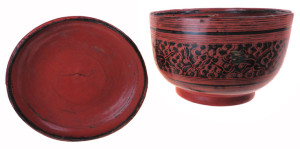
One of the wonderful things about working with the Abbey Museum’s collection is exploring the mysteries of the diverse range of artefacts. My latest research involved the small but fine collection of lacquerware acquired by John Ward when he was living in Burma in 1914 – 1915.
I discovered that lacquerware has been a cultural industry of Burma (Myanmar) for the last three centuries. Because it is light, waterproof, easily moulded and dries to a hard state it has a multitude of uses.
It was used in Buddhist and ceremonial rituals as well as in everyday life of Burmese people at all levels of society. In homes it was the Tupperware of the time, used to store food, clothing, cosmetics, flowers and betel nut. However in temples and palaces the privileged used lacquer boxes to store jewels, letters, and sacred Buddhist manuscripts.

Burmese Lacquerware Treasured
Burmese lacquerware is made from the sap of a tree native to South-east Asia, commonly known as the Thitsee tree. To get a smooth finish, layers of lacquer that are mixed with ash are applied over a base of coiled or woven bamboo, wood or sheet metal. The process is complex and time consuming requiring application and polishing of many layers of lacquer, eventually resulting in a lustrous black surface.
The typical red colouring is from ground cinebar. The art of colouring was a closely guarded secret passed down only from father to his most trusted son. The surface of the object is engraved with a fine stylus and then the incisions are filled with colour which is dried, polished and reapplied several times often with different colours. The final polishing is done with teak charcoal giving a fine lustre.
No wonder Burmese lacquerware was prized and treasured.

One particular item captured my eye. It is a deep lidded lacquerware bowl possibly used for sugar or essential condiments used in Burmese cooking. It is thought to have been made in the 1890s in Bagan which was the centre of lacquerware production. A frieze repeated around the lid and bowl depicts five leaping monkeys in stylised dark green. Leaping monkeys were a common theme in Burmese culture.
Next time you visit the Abbey museum, why not have a closer look at the Burmese lacquerware and be inspired by the skilled work of the artisans who made and decorated these objects.

